For our tour description, itinerary,
past triplists, dates, fees, and more, please VISIT OUR TOUR PAGE.
See this triplist in printable PDF format with media only on
page 1.
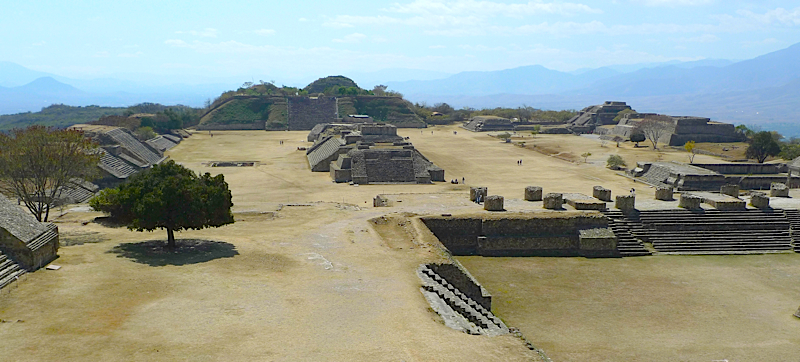
We alway find time
to explore and enjoy the sprawling Zapotec ruins of Monte
Alban, that is, after we've explored the surrounding shrubby
hillsides for birds like Slaty Vireo and Ocellated Thrasher!
(Photo by guide Chris Benesh)
There's nothing like thoughts of a week in the sun to bring
out the snowbird in all of us -- and the possibility of adding
a few dozen Mexican endemics to the life list to make the
prospect even more appealing. From the cool, pine-scented
highlands of the big mountains to the dusty switchbacks above
Teotitlan del Valle, from the majestic columnar cactus forest
around Yagul to the scruffy hillsides along the valley's
highways and byways, there were plenty of feathered
highlights.
A Oaxaca Sparrow peered at us from some nearby weeds, so
close we could almost reach out and touch it. A
spotty-breasted Ocellated Thrasher warbled from a small bush,
pouring his varied phrases into the warm late-morning air. A
pair of Golden Vireos searched for insects (and intruders) as
they worked their way through the roadside vegetation. A tiny
Northern Pygmy-Owl tooted its challenges to the world,
surrounding by an angry mob of warblers, vireos and
hummingbirds. Three Long-tailed Wood-Partridges scrambled
through a fruiting tree, looking for goodies. A horde of
Gray-barred Wrens rooted through bromeliads and mosses on an
oak's shaggy branches. Two Strong-billed Woodcreepers flashed
back and forth across a logging track and crawled up a host of
nearby tree trunks. A tiny Beautiful Hummingbird returned
again and again to the same two perches. Two Zone-tailed Hawks
rocked over the forest, doing their best "Don't mind me, I'm
just a Turkey Vulture" imitations. Boucard's Wrens and Bridled
Sparrows both demonstrated their distinctive wing-waving
territorial displays. Two Chestnut-capped Brush-Finches forgot
themselves (and their typically skulking nature) and climbed
up into a tree for a good look around. Aptly-named Red
Warblers dazzled against the dark green background of the pine
forest.
And, who will soon forget that magical half hour across from
the visitor's center at La Cumbre: two Collared Towhees
calling from a nearby tree, a mob of Black-headed Siskins
nibbling grass seeds, Yellow-eyed Juncos bouncing along the
roadside, swirling flocks of Gray Silky-Flycatchers and a male
Red Crossbill atop a snag. Or our encounter with that
wonderful mixed flock on Cerro San Felipe, when scurrying up
the hill after calling Dwarf Jays led to us being surrounded
by an ever-changing cast of characters: multiple Dwarf Jays
(including one that rested for long minutes in the same spot),
a showy male Rose-throated Becard, a surprise Black-backed
Oriole, chattering Gray-barred Wrens, a bull-necked
Chestnut-sided Shrike-Vireo, raucous Steller's Jays and a shy
Hairy Woodpecker.
Of course, it wasn't just the birds that contributed to the
week's appeal. Guided tours of the sprawling ruins at Monte
Alban, plus the more intimate sites at Yagul and Mitla, gave
us a peek into the Zapotec civilization that once ruled the
valley. An afternoon in the rug-weaving village of Teotitlan
del Valle introduced us to the time-consuming (and labor
intensive) process of turning sheep's wool into rugs. And the
fine local cuisine -- featuring mescals and moles and squash
blossom soup -- ensured that none of us went home hungry. Or
thinner! It was good fun sharing the adventures with all of
you. Chris and I hope to see you in the field again,
somewhere, some day!
-- Megan
For more information about this tour, including future
departures, visit our website at www.fieldguides.com.
And to see this same triplist online, go to https://fieldguides.com/triplists/oax12LIST.pdf
and you will find the list in its entirety.
KEYS FOR THIS LIST
One of the following keys may be shown in brackets for
individual species as appropriate: * = heard only, I =
introduced, E = endemic, N = nesting, a = austral migrant, b =
boreal migrant
Anatidae (Ducks, Geese, and Waterfowl)
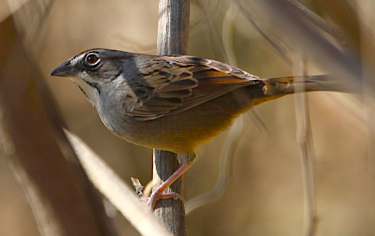
Oaxaca Sparrow is
an aptly-named bird, and a must-find species on this trip,
as its entire range is restricted to the state of Oaxaca.
Though generally tough to come by, this bird was very
well-behaved, and gave us point-blank views! (Photo by
guide Chris Benesh)
GADWALL (Anas
strepera)
AMERICAN WIGEON
(Anas americana)
BLUE-WINGED TEAL
(Anas discors)
CINNAMON TEAL
(Anas cyanoptera)
NORTHERN SHOVELER
(Anas clypeata)
GREEN-WINGED TEAL
(Anas crecca)
RUDDY DUCK
(Oxyura jamaicensis)
Cracidae (Guans, Chachalacas, and
Curassows)
WEST MEXICAN CHACHALACA (Ortalis poliocephala) [E]
Odontophoridae (New World Quail)
LONG-TAILED WOOD-PARTRIDGE (Dendrortyx macroura)
[E]
MONTEZUMA QUAIL
(Cyrtonyx montezumae)
Podicipedidae (Grebes)
LEAST GREBE (Tachybaptus dominicus)
Ardeidae (Herons, Egrets, and Bitterns)
GREAT EGRET (Ardea alba)
SNOWY EGRET
(Egretta thula)
CATTLE EGRET
(Bubulcus ibis)
Cathartidae (New World Vultures)
BLACK VULTURE (Coragyps atratus)
TURKEY VULTURE
(Cathartes aura)
Accipitridae (Hawks, Eagles, and Kites)
WHITE-TAILED KITE (Elanus leucurus)
NORTHERN HARRIER
(AMERICAN) (Circus cyaneus
hudsonius)
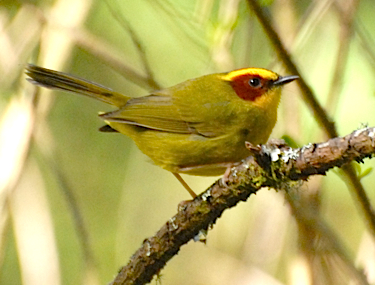
Golden-browed
Warblers are denizens of humid montane forests from Mexico
south into Honduras; this was one of a small party that
delighted the group in an arroyo on Cerro San Felipe.
(Photo by tour participant John Catto)
SHARP-SHINNED HAWK (Accipiter striatus)
COOPER'S HAWK
(Accipiter cooperii)
SHORT-TAILED HAWK
(Buteo brachyurus)
WHITE-TAILED HAWK
(Buteo albicaudatus)
ZONE-TAILED HAWK
(Buteo albonotatus)
RED-TAILED HAWK
(Buteo jamaicensis)
Falconidae (Falcons and Caracaras)
CRESTED CARACARA (Caracara cheriway)
AMERICAN KESTREL
(Falco sparverius)
PEREGRINE FALCON
(Falco peregrinus)
Rallidae (Rails, Gallinules, and Coots)
SORA (Porzana
carolina) [*]
AMERICAN COOT
(Fulica americana)
Charadriidae (Plovers and Lapwings)
KILLDEER (Charadrius
vociferus)
Scolopacidae (Sandpipers and Allies)
SPOTTED SANDPIPER (Actitis macularius)
LEAST SANDPIPER
(Calidris minutilla)
WILSON'S SNIPE
(Gallinago delicata)
Columbidae (Pigeons and Doves)
ROCK PIGEON (Columba livia) [I]
BAND-TAILED PIGEON
(Patagioenas fasciata) [*]
WHITE-WINGED DOVE
(Zenaida asiatica)
MOURNING DOVE
(Zenaida macroura)
INCA DOVE (Columbina inca)
COMMON GROUND-DOVE
(Columbina passerina)
WHITE-TIPPED DOVE
(Leptotila verreauxi) [*]
Strigidae (Owls)
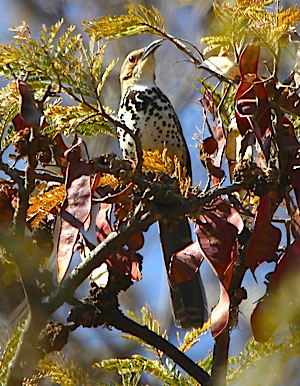
When not singing,
the very local Ocellated Thrasher is a tough bird to find,
spending much of its time on the ground on densely
vegetated hillsides. Luckily for us, they are born to
sing, and they generally prefer to do this from an exposed
perch, as this one did above Teotitlan del Valle! (Photo
by guide Chris Benesh)
NORTHERN PYGMY-OWL (MOUNTAIN) (Glaucidium gnoma gnoma)
Trochilidae (Hummingbirds)
GREEN VIOLETEAR (Colibri thalassinus)
MAGNIFICENT
HUMMINGBIRD (Eugenes fulgens)
BEAUTIFUL
HUMMINGBIRD (Calothorax
pulcher) [E]
BROAD-TAILED
HUMMINGBIRD (Selasphorus
platycercus)
DUSKY HUMMINGBIRD
(Cynanthus sordidus) [E]
BERYLLINE
HUMMINGBIRD (Amazilia
beryllina)
WHITE-EARED
HUMMINGBIRD (Hylocharis
leucotis)
[N]
Trogonidae (Trogons)
MOUNTAIN TROGON (Trogon mexicanus)
Picidae (Woodpeckers)
GRAY-BREASTED WOODPECKER (Melanerpes hypopolius)
[E]
YELLOW-BELLIED
SAPSUCKER (Sphyrapicus varius)
LADDER-BACKED
WOODPECKER (Picoides scalaris)
HAIRY WOODPECKER
(Picoides villosus)
NORTHERN FLICKER
(RED-SHAFTED) (Colaptes
auratus cafer) [*]
Furnariidae (Ovenbirds and Woodcreepers)
STRONG-BILLED WOODCREEPER (Xiphocolaptes promeropirhynchus)
WHITE-STRIPED
WOODCREEPER (Lepidocolaptes
leucogaster) [E]
SPOT-CROWNED
WOODCREEPER (Lepidocolaptes
affinis affinis)
Tyrannidae (Tyrant Flycatchers)
NORTHERN BEARDLESS-TYRANNULET (Camptostoma imberbe) [*]
GREENISH ELAENIA
(Myiopagis viridicata) [*]
PILEATED
FLYCATCHER (Xenotriccus
mexicanus) [E]
TUFTED FLYCATCHER
(Mitrephanes phaeocercus)
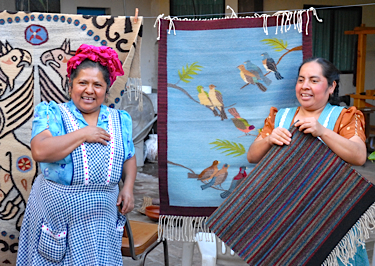
The Mendoza
sisters' rug-weaving demonstration is always a big hit
with our groups. Looks like we've had some influence on
their designs, too! (Photo by tour participant John Catto)
GREATER PEWEE (Contopus pertinax)
LEAST FLYCATCHER
(Empidonax minimus)
HAMMOND'S
FLYCATCHER (Empidonax
hammondii)
DUSKY FLYCATCHER
(Empidonax oberholseri)
BLACK PHOEBE
(Sayornis nigricans)
SAY'S PHOEBE
(Sayornis saya)
VERMILION
FLYCATCHER (Pyrocephalus
rubinus)
DUSKY-CAPPED
FLYCATCHER (Myiarchus
tuberculifer)
ASH-THROATED
FLYCATCHER (Myiarchus
cinerascens)
NUTTING'S
FLYCATCHER (Myiarchus
nuttingi)
GREAT KISKADEE
(Pitangus sulphuratus)
TROPICAL KINGBIRD
(Tyrannus melancholicus)
CASSIN'S KINGBIRD
(Tyrannus vociferans)
THICK-BILLED
KINGBIRD (Tyrannus
crassirostris)
WESTERN KINGBIRD
(Tyrannus verticalis)
Tityridae (Tityras and Allies)
ROSE-THROATED BECARD (Pachyramphus aglaiae)
Laniidae (Shrikes)
LOGGERHEAD SHRIKE (Lanius ludovicianus)
Vireonidae (Vireos)
SLATY VIREO (Vireo brevipennis)
[E]
CASSIN'S VIREO
(Vireo cassinii)
BLUE-HEADED VIREO
(Vireo solitarius)
HUTTON'S VIREO
(Vireo huttoni)
GOLDEN VIREO
(Vireo hypochryseus) [E]
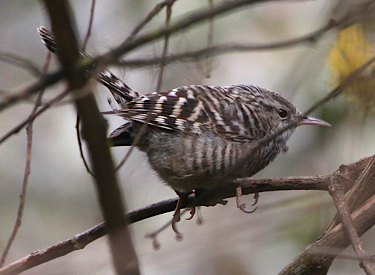
The Gray-barred
Wren is a highly arboreal species; groups of them are
often seen moving through the canopy, checking clumps of
bromeliads for tasty bugs. Dwarf Jays often accompany
them, and we always hope to find one of these big mixed
jay/wren flocks during our time in the mountains. (Photo
by guide Chris Benesh)
WARBLING VIREO (Vireo gilvus)
CHESTNUT-SIDED
SHRIKE-VIREO (Vireolanius
melitophrys)
Corvidae (Crows, Jays, and Magpies)
DWARF JAY (Cyanolyca
nana) [E]
STELLER'S JAY
(Cyanocitta stelleri)
WESTERN SCRUB-JAY
(SUMICHRAST'S) (Aphelocoma
californica sumichrasti)
COMMON RAVEN
(Corvus corax)
Hirundinidae (Swallows)
NORTHERN ROUGH-WINGED SWALLOW (Stelgidopteryx serripennis)
VIOLET-GREEN
SWALLOW (Tachycineta
thalassina)
Paridae (Chickadees and Tits)
MEXICAN CHICKADEE (Poecile sclateri)
BRIDLED TITMOUSE
(Baeolophus wollweberi)
Sittidae (Nuthatches)
WHITE-BREASTED NUTHATCH (Sitta carolinensis)
Troglodytidae (Wrens)
GRAY-BARRED WREN (Campylorhynchus megalopterus) [E]
BOUCARD'S WREN
(Campylorhynchus jocosus)
[E]
ROCK WREN (Salpinctes obsoletus)
CANYON WREN
(Catherpes mexicanus)
HAPPY WREN
(Pheugopedius felix)
[*]
BEWICK'S WREN
(Thryomanes bewickii) [*]
HOUSE WREN
(NORTHERN) (Troglodytes aedon
aedon)
HOUSE WREN
(BROWN-THROATED) (Troglodytes
aedon brunneicollis)
MARSH WREN
(Cistothorus palustris)
GRAY-BREASTED
WOOD-WREN (Henicorhina
leucophrys) [*]
Polioptilidae (Gnatcatchers)
BLUE-GRAY GNATCATCHER (Polioptila caerulea)
Regulidae (Kinglets)
RUBY-CROWNED KINGLET (Regulus calendula)
Turdidae (Thrushes and Allies)
BROWN-BACKED SOLITAIRE (Myadestes occidentalis)
ORANGE-BILLED
NIGHTINGALE-THRUSH (Catharus
aurantiirostris)
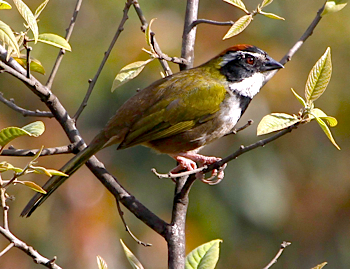
A pair of endemic
Collared Towhees were part of a parade of birds that
brought a little magic to a morning at the visitor's
center at La Cumbre. (Photo by guide Chris Benesh)
RUSSET NIGHTINGALE-THRUSH (Catharus occidentalis) [E]
SWAINSON'S THRUSH
(Catharus ustulatus)
HERMIT THRUSH
(Catharus guttatus)
CLAY-COLORED
THRUSH (Turdus grayi)
RUFOUS-BACKED
ROBIN (Turdus rufopalliatus)
[E]
AMERICAN ROBIN
(Turdus migratorius) [*]
Mimidae (Mockingbirds and Thrashers)
NORTHERN MOCKINGBIRD (Mimus polyglottos)
OCELLATED THRASHER
(Toxostoma ocellatum) [E]
CURVE-BILLED
THRASHER (Toxostoma
curvirostre)
BLUE MOCKINGBIRD
(Melanotis caerulescens)
[E]
Motacillidae (Wagtails and Pipits)
AMERICAN PIPIT (Anthus rubescens)
Ptilogonatidae (Silky-flycatchers)
GRAY SILKY-FLYCATCHER (Ptilogonys cinereus)
Peucedramidae (Olive Warbler)
OLIVE WARBLER (Peucedramus taeniatus)
Parulidae (New World Warblers)
LOUISIANA WATERTHRUSH (Parkesia motacilla)
BLACK-AND-WHITE
WARBLER (Mniotilta varia)
CRESCENT-CHESTED
WARBLER (Oreothlypis
superciliosa)
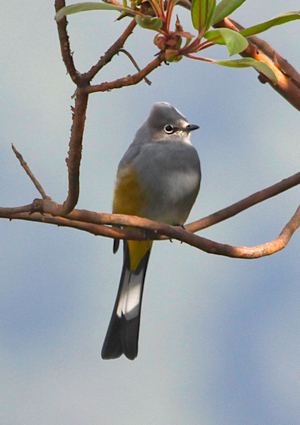
Adding to the
magic at the La Cumbre visitor's center were several sleek
Gray Silky-Flycatchers that posed beautifully in the tree
tops. (Photo by guide Chris Benesh)
ORANGE-CROWNED WARBLER (Oreothlypis celata)
NASHVILLE WARBLER
(Oreothlypis ruficapilla)
VIRGINIA'S WARBLER
(Oreothlypis virginiae)
MACGILLIVRAY'S
WARBLER (Geothlypis tolmiei)
COMMON
YELLOWTHROAT (Geothlypis
trichas)
YELLOW-RUMPED
WARBLER (MYRTLE) (Setophaga
coronata coronata)
YELLOW-RUMPED
WARBLER (AUDUBON'S) (Setophaga
coronata auduboni)
BLACK-THROATED
GRAY WARBLER (Setophaga
nigrescens)
TOWNSEND'S WARBLER
(Setophaga townsendi)
HERMIT WARBLER
(Setophaga occidentalis)
RUFOUS-CAPPED
WARBLER (NORTH MEXICO) (Basileuterus
rufifrons rufifrons)
GOLDEN-BROWED
WARBLER (Basileuterus belli)
WILSON'S WARBLER
(Cardellina pusilla)
RED-FACED WARBLER
(Cardellina rubrifrons)
RED WARBLER
(Cardellina rubra) [E]
PAINTED REDSTART
(Myioborus pictus)
SLATE-THROATED
REDSTART (Myioborus miniatus
miniatus)
Emberizidae (Buntings, Sparrows and
Allies)
WHITE-COLLARED SEEDEATER
(CINNAMON-RUMPED) (Sporophila
torqueola torqueola)
[E]
CINNAMON-BELLIED
FLOWERPIERCER (Diglossa
baritula baritula)
CHESTNUT-CAPPED
BRUSH-FINCH (CHESTNUT-CAPPED) (Arremon
brunneinucha suttoni)
COLLARED TOWHEE
(Pipilo ocai) [E]
SPOTTED TOWHEE
(Pipilo maculatus)
RUFOUS-CROWNED
SPARROW (Aimophila ruficeps)
OAXACA SPARROW
(Aimophila notosticta) [E]
WHITE-THROATED
TOWHEE (Melozone albicollis)
[E]
BRIDLED SPARROW
(Peucaea mystacalis) [E]
CHIPPING SPARROW
(Spizella passerina)
CLAY-COLORED
SPARROW (Spizella pallida)
LARK SPARROW
(Chondestes grammacus)
GRASSHOPPER
SPARROW (Ammodramus
savannarum)
LINCOLN'S SPARROW
(Melospiza lincolnii)
YELLOW-EYED JUNCO
(Junco phaeonotus)
Cardinalidae (Cardinals and Allies)
HEPATIC TANAGER (NORTHERN) (Piranga flava hepatica)
SUMMER TANAGER
(Piranga rubra)
WESTERN TANAGER
(Piranga ludoviciana)
BLACK-HEADED
GROSBEAK (Pheucticus
melanocephalus)
BLUE GROSBEAK
(Passerina caerulea)
INDIGO BUNTING
(Passerina cyanea)
Icteridae (Troupials and Allies)
EASTERN MEADOWLARK (Sturnella magna)
GREAT-TAILED
GRACKLE (Quiscalus mexicanus)
BRONZED COWBIRD
(Molothrus aeneus)
BLACK-VENTED
ORIOLE (Icterus wagleri)
HOODED ORIOLE
(Icterus cucullatus)
BULLOCK'S ORIOLE
(Icterus bullockii)
AUDUBON'S ORIOLE
(DICKEY'S) (Icterus
graduacauda dickeyae) [E]
BALTIMORE ORIOLE
(Icterus galbula)
BLACK-BACKED
ORIOLE (Icterus abeillei)
[E]
SCOTT'S ORIOLE
(Icterus parisorum)
Fringillidae (Siskins, Crossbills, and
Allies)
ELEGANT EUPHONIA (Euphonia elegantissima)
HOUSE FINCH
(COMMON) (Carpodacus mexicanus
roseipectus)
RED CROSSBILL
(Loxia curvirostra)
BLACK-HEADED
SISKIN (Spinus notatus)
LESSER GOLDFINCH
(Spinus psaltria)
Passeridae (Old World Sparrows)
HOUSE SPARROW (Passer domesticus) [I]
MEXICAN GRAY
SQUIRREL (Sciurus aureogaster)
HISPID COTTON RAT
(Sigmodon hispidus)
We had only a single reptile on this trip: a West Mexican
Coral Snake (Micrurus distans) seen as it oozed back into the
leaf litter around one of the tombs at Monte Alban.
Totals for the tour: 178 bird taxa and 2 mammal taxa








